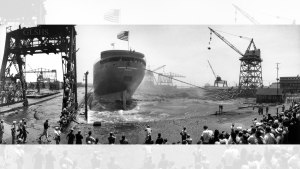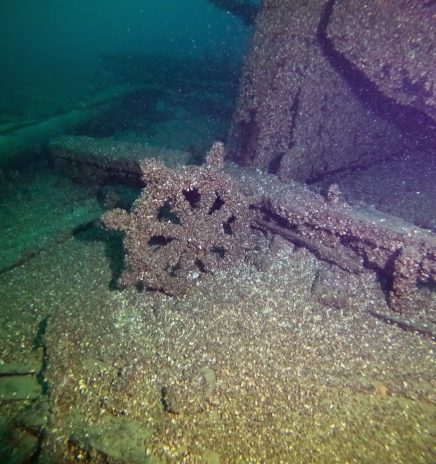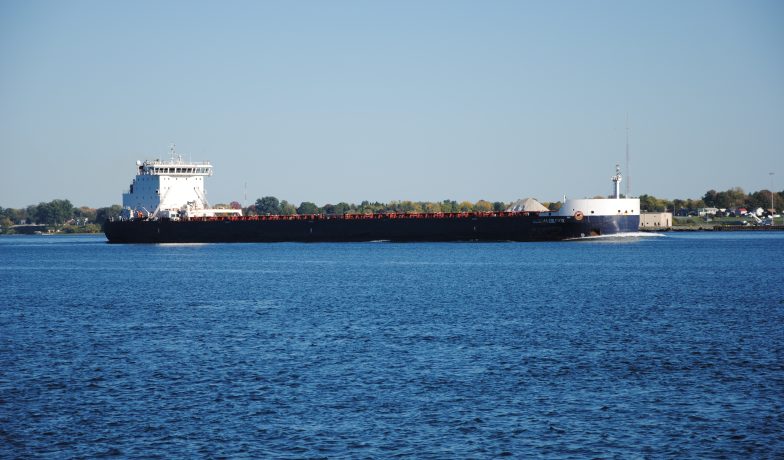1958: The Year that Remade Great Lakes Shipping
These four massive and exceptionally challenging construction projects, occurring at roughly the same time, would change Great Lakes shipping forever.
In 1955, America celebrated what the Lake Carriers’ Association called the 100th anniversary of Great Lakes shipping, a celebration linked to the centennial of the original Soo Locks. Given that, it is fair to say that 1958, with its series of transformational events, can be appropriately called the beginning of the modern era of Great Lakes shipping, a hinge point in Midwest and even American maritime history.
The Seaway Opens
CBS newsman Walter Cronkite, “the most trusted man in America” at the time, did not hold back when describing the construction of the St. Lawrence Seaway. Cronkite called it “the greatest engineering feat of our time.” The construction of a waterborne transportation path from the Atlantic Ocean to America’s heartland was, Cronkite said, “one of the greatest projects in the history of mankind,” a project so important that it amounted to “reshaping a continent by … creating an eighth sea … a sea of opportunity.”
The immensely challenging project included excavations, dredging and movement of hundreds of millions of cubic yards of dirt in or around the St. Lawrence River and construction of seven locks that would lift vessels hundreds of feet as they traveled from the Atlantic Ocean to Lake Ontario and from there onto the other Great Lakes. In one case, an entire town in Canada was relocated to make way for the new Seaway. The project, which began in 1954 and was mostly completed in 1958, involved 22,000 workers. (For a fascinating visual and narrative summary of what was involved, see “The Eighth Sea,” released in 1958 and narrated by Cronkite, available on YouTube.)
The goal, of course, was to open Great Lakes cities to larger vessels from around the world. Railroads and East Coast ports fought against the Seaway construction, believing that the project would siphon off their own cargo.
The massive construction project eventually went forward, and today the Seaway is a major trade artery, opening the Midwest to “salties” from around the world. Cargo vessels of all types and now a new generation of cruise ships pass through the Seaway on a regular basis. The St. Lawrence Seaway project has profoundly shaped the Midwest and Great Lakes in both positive and negative ways, exactly what you’d expect of a project of this magnitude. The Seaway’s formal dedication ceremony featured U.S. President Dwight Eisenhower and Queen Elizabeth II. President Eisenhower highlighted the U.S.-Canadian cooperation in building a waterway “linking the oceans of the world with the Great Lakes of the American continent.”
The Mackinac Bridge
The Straits of Mackinac is the waterway at which Lake Michigan, Lake Huron and the nearby St. Mary’s River come together. The Straits literally separate the Upper and Lower peninsulas of Michigan. It is hard to imagine today, but at the time of Michigan statehood in 1837 and for more than 100 years after, the two parts of the state were separated by at least 5 miles of open water. The Anishinaabeg Native Americans held the Straits in such high regard that they called them the Gchi Mshiiken Deh Minising or “Heart of the Great Turtle Island,” describing the Straits as the heart of North America. The Straits’ role as a transportation hub dates back long before there was a United States.

How audacious the idea of building a 5-mile-long suspension bridge across the Straits was in the 1950s!. Before then, the preferred means of transportation across were ferries that would carry passengers, cars and even railcars across. One famous car ferry was the Chief Wawatam, which operated between St. Ignace and Mackinaw City. Weather and other factors often made passage unpredictable. During deer hunting season, when Lower Peninsula residents traveled north, the line of cars waiting to go across on the Chief sometimes stretched for miles.
The idea of a bridge spanning the Straits dates to the 1800s, but after countless unsuccessful efforts, construction finally began in the mid-1950s and was completed in late in 1957 with the dedication ceremony in 1958.
The new bridge impacted shipping in real and symbolic ways. First, the “Mighty Mac” spelled the beginning of the end for the local car ferries, with their needs at the Straits greatly reduced. (Today, the last of the car ferries still operating on the Lakes is the SS Badger, homeported in Ludington, Michigan.) Second, Great Lakes vessels traveling along many important trade routes – including from the Minnesota and Michigan iron mines to the Indiana steel mills – had a new obstacle, the bridge itself, to avoid in what is already a busy waterway. Finally, the “Might Mac” has become an iconic symbol of Great Lakes transportation, a breathtaking image over the crossroads of Great Lakes shipping.
A 1,000+ Foot Lock in the Soo
Sault Ste. Marie, Michigan, is widely known as the “oldest city in Michigan,” founded by Father Jacques Marquette more than a century before the United States itself, and there has been a navigation lock in “the Soo” since the mid-1800s. The lock is needed to allow vessel transportation between Lake Superior and other Great Lakes because of a dramatic change in elevation. More than 10,000 vessels move through the locks annually, including large vessels carrying taconite from the Lake Superior mines to steel mills below.
As Great Lakes ships have grown in size, so have the locks to accommodate them. Government locks were constructed in 1855 (the State Lock), 1881 (the Weitzel Lock), 1896 (the original Poe Lock), 1914 (the Davis Lock), 1919 (the Sabin Lock) and 1943 (the MacArthur Lock). The original Poe Lock was rebuilt and expanded in 1968.
In 1958, the Army Corps of Engineers began planning for the construction of the second Poe Lock, a 1,200-foot structure that would be the first big enough to accommodate the Great Lakes’ most iconic vessels – the 1,000-footers. Ten years later, the new Lock’s construction was complete, and before long the first of the “footers,” the Stewart J. Cort, sailed through in 1972.
The “Fitz” is Born
On June 7, 1958, an estimated 10,000 people attended the launch of the SS Edmund Fitzgerald in River Rouge, Michigan. It was a big ship for its day, in fact, the largest ship on the lakes then, “the Queen of the Lakes.” For 17 years the 730-foot-long vessel carried taconite from the mines to the steel mills. But, of course, much of its fame today can be traced to its tragic sinking on November 9, 1975, in a fierce November storm, with a loss of all 29 aboard just 17 miles from Whitefish Bay, Michigan.

One year later, Canadian singer/songwriter Gordon Lightfoot released his haunting ballad, “The Wreck of the Edmund Fitzgerald,” immortalizing the loss of the ill-fated vessel “on the Great Lake they call Gitche Gumee” and brought the dangers of Great Lakes shipping to the masses. The song reached the top of both the Canadian and American music charts. Suddenly people who knew nothing about shipping were introduced to the gales of November and the challenges of the Great Lakes maritime business.
The catastrophe and the song brought public attention to Great Lakes shipping like nothing else could. Even today, nearly half a century later, the song is well known. Lightfoot later became a friend and supporter of the Great Lakes Maritime Academy in Traverse City, Michigan, where many Great Lakes sailors are educated. The sinking, and perhaps the public attention from the song, also led to many changes in the regulation of Great Lakes shipping. Expect additional attention this November 9, on the 50th anniversary of the Great Lakes’ most famous maritime disaster. The Great Lakes Shipwreck Historical Society will hold a memorial ceremony at Whitefish Point on Monday, November 10th, 2025. For more information go to shipwreckmuseum.com/edmund-fitzgerald/
In Conclusion
1958 and the years after have reshaped Great Lakes shipping perhaps like no other period in history, yet this important stretch of shipping progress has gone mostly unnoticed and unheralded, despite its indelible impact.

50th Anniversary of the Sinking of the SS Edmund Fitzgerald
It has been 50 years since the tragic sinking of the SS Edmund Fitzgerald on Lake Superior. On November 10, 1975, the Great Lakes freighter sank during a storm just... Read More

Wreckage of F.J. King Found After 139 Years
The Wisconsin Underwater Archeology Association (WUAA) has announced the discovery of the long-sought wreck of the schooner F.J. King, which sank in a storm off Baileys Harbor, Wisconsin, on September... Read More

